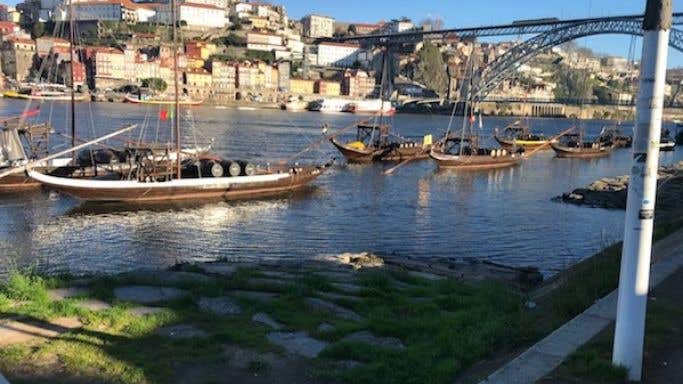A version of this article is published by the Financial Times.
Oporto, on New Year’s Eve, was a city basking in unseasonably warm sunshine as its citizens promenaded and its many tourists filled the cafes on both sides of the river Douro. The city, which, other than for its many port lodges and steep, cobbled streets, has reinvented itself as a magnet for visitors over the last 10 or 15 years, provided two completely contrasting restaurants.
One comes highly recommended for dinner, the only meal served, the other for lunch with a decidedly local flavour. The former boasts windows that offer a panoramic view across the atmospherically lit city, the other no view and virtually no decor. One boasts the most succinct, but perhaps longest, tasting menu with 10 courses plus a plethora of amuse-bouches, the other just a vast list of seafood and fish dishes.
The former, The Restaurant in The Yeatman hotel, aims to offer the very best of the increasingly fine wines of Portugal, while the latter, A Marisqueira de Matosinhos, a 20-minute coastward drive from the centre, aims to highlight locally caught fish and shellfish. And they each take a very different approach to apportioning the credit. The wine list at The Restaurant lists not only the hugely knowledgeable Beatriz Machado as its Wine Director but also Fernando Lapa and Miguel Santos as its cellar hands, while the menu and the wine list at the bustling seafood restaurant acknowledge nobody, although I would put in a word for Manuel Sousa, our hard-working waiter.
An interview with Ricardo Costa, The Yeatman’s executive chef, in the hotel’s glossy Wine Journal, a magazine cleverly left in every bedroom, served only to whet my appetite for dinner. Asked which dish he would serve to someone trying Portuguese food for the first time, to another chef and to his mother, his answers were respectively his sardine dish, suckling pig and his version of fish broth. All of which excited me.
The restaurant itself is as quiet as those in most hotels, with the focus on the food, the view, and here the wine service. What ensues is a ritualised performance in which the kitchen is very much in charge.
Of the several amuse-bouches, two stood out. The first was a trio of small bites of tuna, of which the highlight was the third, a piece of toro, the fatty underbelly, in a wafer-thin sesame sandwich. The second was several thin slices of amberjack sashimi, the fish enlivened by a cucumber theme.
The first serious main dish was equally good, pieces of lobster under a cauliflower purée with the addition of small ravioli and sweetbreads. Then on to the promised suckling pig, not a large piece but one topped with excellent crackling. But the real excitement came with its accompanying sauce, an acidulated purée but this time of Jerusalem artichokes. So much depth of flavour from a vegetable the French once considered fit only for cattle feed! But it was our dessert that provided the highlight. Not a long drawn out affair, as is so often the case with a tasting menu, but simply two dishes, a chocolate soufflé and cherries topped with vanilla ice cream that we were instructed to eat together and which provided a stunning finale.
The highlights of the five wines we enjoyed, selected by Machado, were a white 2017 Verdelho from the island of Pico in the Azores, and a 2012 Pardusco Private red blend from Vinho Verde country to the north. The other 1,195 mainly Portuguese wines on this spectacular, and keenly priced, list will have to wait for our return.
Price was another differentiator between these two restaurants. Whereas dinner costs €170 per person at The Restaurant, a price that includes great views and vast empty spaces (a defining characteristic of this hotel) between the tables, our bill at the second restaurant, with two bottles of wine and a glass of port, was €263. For five.

The tables may be very much closer together at the Marisqueira, but there has to be room for two additions. The first is a large saltwater tank, home to an enormous array of large shellfish that is just this side of a counter that seats 12. On the other side of the counter is a table of shellfish, lobster, crabs and barnacles as well as prawns and langoustines of varying sizes, which have just been cooked and are ready to serve. And because this was New Year’s Eve, one corner of the restaurant was piled high with what must have been over 100 boxes of shellfish that had been ordered for that night’s supper in many local households. As we left we had to fight our way past a long line of customers anxious to collect their orders.

We began with a couple of shared dishes, some percebes or barnacles and a spider crab whose shell had been hollowed out and refilled with creamy, slightly spiced, crabmeat. We wanted to order two but Manuel rightly assured us one was enough. A bowl of well-seasoned fish broth; a generous half portion of the local speciality, almost liquid seafood rice; a dish of sautéed squid; and a couple of portions of octopus with octopus rice combined to leave just enough appetite for a slice of sweet almond tart as dessert.

Conversation that night with an Englishman long resident in this engaging city quickly turned to Oporto’s burgeoning restaurant scene. He opined that the biggest difference lies not in the reliably high quality of the raw ingredients, nor in the professionalism of the cooking, but in the level, training and knowledge of the service provided. Here The Restaurant, supported by the infrastructure of the hotel, really scored and fully justified every accolade, including its two Michelin stars.

